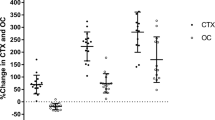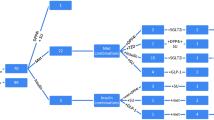Abstract
Introduction
Low-carbohydrate diets have become popular as weight loss techniques. These diets are high in protein, saturated fats, and omega-6 fatty acids. They also lead to a ketogenic state. These factors could lead to increased bone turnover. This study was designed to see whether a low-carbohydrate diet would lead to increased bone turnover in humans.
Methods
Thirty patients (15 study subjects and 15 controls) were recruited for this 3-month study. The 15 patients on the diet were instructed to consume less than 20 g of carbohydrates per day for the 1st month and then less than 40 g per day for months 2 and 3. Control subjects had no restrictions on their diet. The primary end point was urinary N-telopeptide (UNTx) at 3 months. Secondary end points included UNTx at 1 month, bone-specific alkaline phosphatase (BSAP) at 1 month, bone turnover ratio (BSAP/UNTx) at 1 month, and weight loss.
Results
The mean UNTx in the study subjects increased by 1.6 [95% confidence interval (CI) ±22.8] compared with an increase of 1.9 (95% CI ±17.6) in the controls at 3 months (p=0.86). The mean UNTx decreased by 2.2 (95% CI ±27.2) and 3.1 (95% CI ±17.6) at 1 month in the dieters and controls, respectively (p=0.36). The mean BSAP decreased by 0.53 (95% CI ±2.96) in the dieters and increased by 0.34 (95% CI ±2.92) in the controls at 1 month (p=0.27). The bone turnover ratio increased by 0.08 (95% CI ±0.81) in the dieters and by 0.05 (95% CI ± 0.27) in the controls at 1 month (p=0.78). The dieters lost 6.39 kg versus 1.05 kg for the controls at 3 months (p=0.0008).
Conclusions
Although the patients on the low-carbohydrate diet did lose significantly more weight than the controls did, the diet did not increase bone turnover markers compared with controls at any time point. Further, there was no significant change in the bone turnover ratio compared with controls.




Similar content being viewed by others
References
Barzel US, Massey LK (1998) Excess dietary protein can adversely affect bone. J Nutr 128(6):1051–1053
Sun L, Tamaki H, Ishimaru T et al (2004) Inhibition of osteoporosis due to restricted food intake by fish oils DHA and EPA and perilla oil in the rat. Biosci Biotechnol Biochem 68(12):2613–2615
Fernandes G, Lawrence R, Sun D (2003) Protective role of –3 lipids and soy protein in osteoporosis. Prostaglandins Leukot Essent Fat Acids 68(6):361–372
Kelly O, Cushing KD (2004) The effect of conjugated linoleic acid on calcium absorption and bone metabolism and composition in adult ovariectomised rats. Prostaglandins Leukot Essent Fat Acids 71(5):295–301
MacDonald HM, New SA, Golden MH, Campbell MK, Reid DM (2004) Nutritional association with bone loss during menopausal transition: evidence of a beneficial effect of calcium, alcohol, and fruit and vegetable nutrients and detrimental effects of fatty acids. Am J Clin Nutr 79(1):155–165
Wohl GR, Loehrke L, Watkins BA, Zernicke RF (1998) Effects of a high-fat diet on mature bone mineral content, structure, and mechanical properties. Calcif Tissue Int 63:74–79
Watkins BA, Li Y, Seifert MF (2001) Lipids as modulators of bone remodeling. Curr Opin Clin Nutr Metab Care 4(2):105–110
Kettler DB (2001) Can manipulation of the ratios of essential fatty acids slow the rapid rate of postmenopausal bone loss? Altern Med Rev 6(1):61–77
Hou JC-H, Zernicke RF, Barnard RJ (1990) High-fat sucrose diet effects on femoral neck geometry and biomechanics. Clin Biomech 5:162–168
Li K-C, Zernicke RF, Barnard RJ, Li AF-Y (1990) Effects of a high-fat diet on cortical bone morphology and biomechanics. Calcif Tissue Int 47:308–313
Zernicke RF, Salem GJ, Barnard RJ, Schramm E (1995) Long-term, high-fat sucrose diet alters rat femoral neck and vertebral morphology, bone mineral content, and mechanical properties. Bone 16:25–31
Albertazzi P, Coupland K (2002) Polyunsaturated fatty acids. Is there a role in postmenopausal osteoporosis prevention? Maturitas 42(1):13–22
Heaney RP (1993) Protein intake and the calcium economy. J Am Diet Assoc 93:1259–1260
Kerstetter JE, Mitnick ME, Gundberg CM et al (1999) Changes in bone turnover in young women consuming different levels of dietary protein. J Clin Endocrinol Metab 84(3):1052–1055
Atteh JO, Leeson S (1984) Effects of dietary saturated or unsaturated fatty acids and calcium levels on performance and mineral metabolism of broiler chicks. Poultry Sci 62:2403–2411
Bettica P, Bevilacqua M, Vago T et al (1997) Short-term variations in bone remodeling biochemical markers: cyclical etidronate and alendronate effects compared. J Clin Endocrinol Metab 82(9):3034–3039
Bekker PJ, Holloway DL, Rasmussen AS et al (2004) A single-dose placebo-controlled study of AMG 162, a fully human monoclonal antibody to RANKL, in postmenopausal women. J Bone Miner Res 19(7):1059–1066
Prior JC, Vigna YM, Wark JD et al (1997) Premenopausal ovariectomy-related bone loss: a randomized, double-blind, one-year trial of conjugated estrogen or medroxyprogesterone acetate. J Bone Miner Res 12(11):1851–1863
Yasumizu T, Fukada Y, Hoshi K (1999) Changes in serum levels of type I collagen-related proteins after surgically induced menopause and correlations with bone loss in the lumbar spine. Endocr J 46(2):337–343
Peris P, Alvarez L, Monegal A et al (1999) Biochemical markers of bone turnover after surgical menopause and hormone replacement therapy. Bone 25(3):349–353
Chao DEM, Farmer D, Register T et al (2000) Effect of voluntary weight loss on bone mineral density in older overweight women. J Am Geriatr Soc 48:753–759
Ricci TA, Heymsfield SB, Pierson RN et al (2001) Moderate energy restriction increases bone resorption in obese postmenopausal women. Am J Clin Nutr 73:347–352
Samaha FF, Iqbal N, Seshadri P et al (2003) A low-carbohydrate as compared with a low-fat diet in severe obesity. N Engl J Med 348(21):2074–2081
Yancy WS, Olsen MK, Guyton JR et al (2004) A low-carbohydrate, ketogenic diet versus a low-fat diet to treat obesity and hyperlipidemia. Ann Intern Med 140(10):769–777
Dansinger ML, Gleason JA, Griffith JL, Selker HP, Schaefer EJ (2005) Comparison of the Atkins, Ornish, Weight Watchers, and Zone diets for weight loss and heart disease risk reduction: a randomized trial. JAMA 293(1):43–53
Acknowledgement
This research was supported by an investigator-initiated grant from the Regional Grants in Aid (RGIA), Procter & Gamble.
Author information
Authors and Affiliations
Corresponding author
Rights and permissions
About this article
Cite this article
Carter, J.D., Vasey, F.B. & Valeriano, J. The effect of a low-carbohydrate diet on bone turnover. Osteoporos Int 17, 1398–1403 (2006). https://doi.org/10.1007/s00198-006-0134-x
Received:
Accepted:
Published:
Issue Date:
DOI: https://doi.org/10.1007/s00198-006-0134-x




